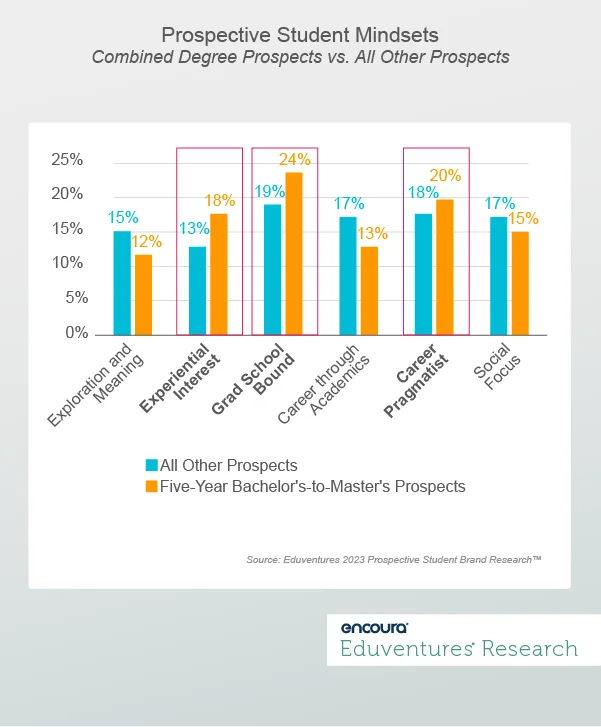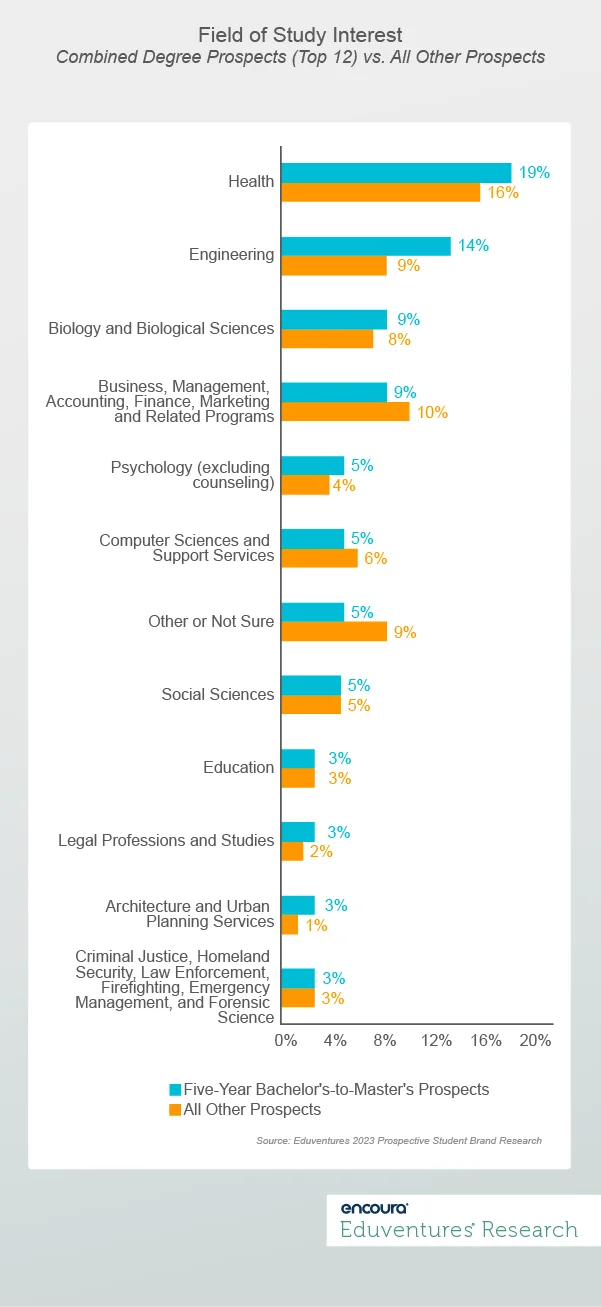Among adult prospects, master’s degree interest has fallen alongside the rise of the non-degree market. Indeed, the National Student Clearinghouse reported a 1.2% enrollment decline in fall 2022—the first in many years. Fall 2023 data reveals that the market is holding steady but remains below 2021 levels.
Some schools have turned to combined degree programs (bachelor’s + master’s) as a strategic gambit to ignite interest among a younger student cohort and keep them enrolled for an additional year or two. But a recurring narrative has emerged from schools expressing disappointment that these programs often fall short of expectations.
This suggests that institutions have not been as strategic as necessary to launch such programs, begging the question: who exactly are combined degree prospects?
Growing Interest
Combined or accelerated degree programs (e.g., 4+1 or 3+2 bachelor’s-to-master’s degree programs) can be a win-win proposition. Students benefit from fast-tracked programming that saves time and money and equips them with advanced skills to enter the labor market in a specialized field. Institutions benefit from creating more reliable master’s program pipelines and cultivating brand loyalty.
But sizing the combined degree market is challenging. There is no data source that reports on these programs specifically, and NCES IPEDS data requires triangulation and will only get you so far.
Where program market data is lacking, however, Eduventures has robust information about who combined degree prospects are and what expectations and preferences they have for their higher education journeys.
Eduventures’ Prospective Student Research™ reveals that the proportion of combined degree-interest prospects has grown in the post-pandemic college pipeline. When asked which path prospects were most likely to pursue for their first degree, 11% of high school sophomores, juniors, and seniors surveyed in 2019 responded “complete a five-year bachelor’s-to-master’s program.” In 2023, this prospect group rose to 14%—a statistically significant increase.
In an increasingly competitive market, tapping into this interest earlier may become more critical for schools looking to boost differentiation or maintain master’s market share.
Who are these combined degree prospects?
First and foremost, combined degree prospects have a higher level of confidence and maturity than their peers. For example, combined degree prospects are more likely than their peers to view college as a means of learning professional conduct and gaining knowledge. On the flip side, their peers more often cite expectations for learning responsibility and developing self-esteem.
Eduventures’ Prospective Student Mindsets™ (Mindsets) shed further light on these prospects’ core motivations. Figure 1 compares Mindset distribution between combined degree prospects and their peers.
Figure 1.
This indicates that 62% of combined degree prospects fall into either the Grad School Bound, Career Pragmatist, or Experiential Interest Mindsets, compared to 50% of their peers (with statistically higher incidence in the Grad School Bound and Experiential Interest Mindsets). This reveals that combined degree prospects are mostly driven by academics and career rather than other kinds of college experiences.
While it’s not surprising that the highest proportion of these prospects are Grad School Bound (24%), additional details offer more insight. Let’s consider some of the underlying responses that inform the Mindset analysis:
- Top Expectations: Like all other prospective students, getting a good job after graduation is the top expectation for combined degree prospects, but there is some daylight between these two groups. For example, combined degree prospects report higher expectations around “master an academic subject,” “learn to be a leader,” “gain scientific, math, or tech skills,” and “learn how to conduct research” compared to their peers.
- Top Learning Experiences: While all other prospects report higher emphasis around “interactions with other students,” “cultural events on campus,” and “participation in clubs,” combined degree prospects report higher expectations around learning from “internships,” “research opportunities with faculty,” and “work study employment.”
- Application Drivers: While all prospects report “academic strength” as the top application driver, combined degree prospects placed even higher importance on this characteristic (57% vs. 65%) which includes things like program quality and faculty expertise. A school’s social environment, on the other hand, is less important for this group.
Another key piece of information is what they want to study. Figure 2 compares field of study interest between combined degree prospects and all others.
Figure 2.
Health is the top broad field of interest for both prospect groups. Engineering, however, is the second top field of interest for combined degree prospects, while business enters the second spot for all other prospects. Aside from those two fields, combined degree prospects also report statistically higher interest in psychology and architecture.
The Bottom Line
Through our Prospective Student Brand Data, a profile of combined degree prospects emerges. These prospects are driven by academics as a pathway to graduate school, which is viewed as a springboard to a career. They want to master an academic subject and learn critical skills – and do so through hands-on experiences like internships and research. A school’s academic quality, which impacts individual program quality, is their top interest driver.
Insights like these can help institutions craft more effective messaging for combined degree programs and, more critically, craft the desired student experience within these degree programs to ensure prospects find what they are looking for.



